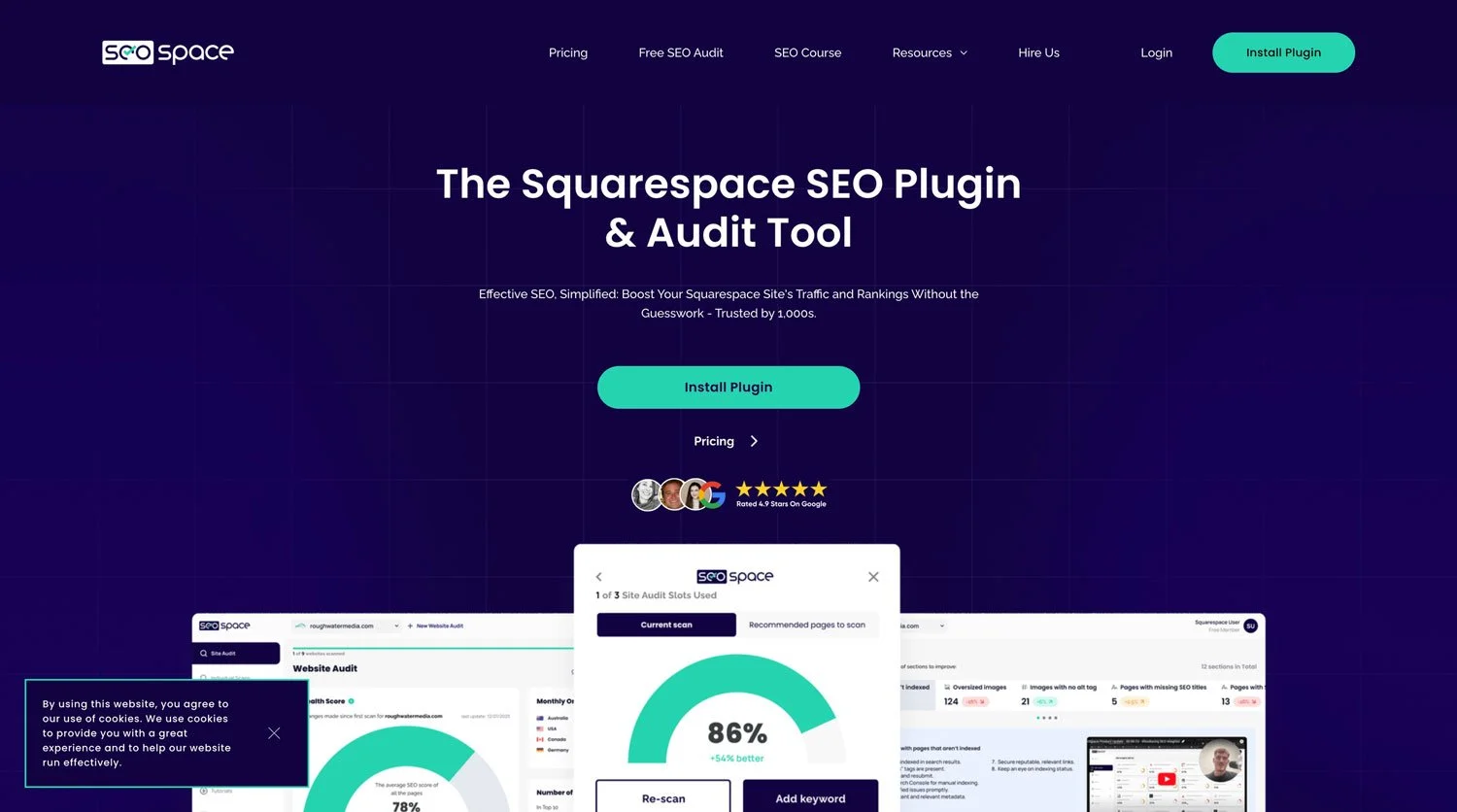Squarespace Affiliate Marketing: How to Earn Passive Income
Running a business often means your income is tied to how much you can show up. Take time off, and sales slow. Push too hard, and burnout follows.
Affiliate marketing transforms your content into a source of income that doesn’t demand constant output. Here, we’ll look at the foundations of affiliate marketing, how to begin, and how Squarespace affiliate marketing can help you build a lasting stream of passive income.
This post contains affiliate links. If you click and make a purchase, we might earn a small commission at no extra cost to you. We only recommend products we love and trust. Find our affiliate disclosure here.
What is Affiliate Marketing?
Simply put, affiliate marketing is where you share products and services that you believe in. When someone clicks your affiliate link and makes a purchase, you earn a commission. Commission rates vary, often between 5% and 50% depending on the program.
This typically looks like:
You recommend a product from a brand (Store A) on your website, blog, or social channel.
A reader clicks the affiliate link you’ve provided.
If they make a purchase, the affiliate program tracks it.
You earn a portion of the sale.
The beauty of affiliate marketing is that it rewards both sides: your audience gains thoughtful recommendations, and you create a passive income stream.
Why Use Squarespace for Affiliate Marketing?
Squarespace has several features that can help you optimize content for affiliate marketing:
Considered design
Squarespace templates give you a framework to create resource pages, curated guides, or members-only areas that hold your affiliate content in a way that feels aligned with your brand.
Built-in SEO
Instead of wrestling with endless plugins, Squarespace gives you the essentials upfront: clean code, customizable meta data, and structured headings.
Analytics
With integrated analytics, you can see which posts attract clicks, which links convert, and where your audience lingers. That data helps you refine your affiliate approach.
Content
Squarespace is designed for publishing. Every plan includes blogging that makes it easy to write, format, and share content.
How to Find Affiliate Programs for Your Niche
Affiliate marketing is most effective when the products you recommend are ones you’d genuinely use and talk about. Choosing the right programs is about curating partnerships that support your offer and niche:
Affiliate networks
If you’re new, networks like CJ Affiliate, Impact, or Amazon Associates give you access to hundreds of brands in one place. They’re a good starting point for exploring options and testing what suits your audience.
Direct brand partnerships
Sometimes the most natural opportunities come from the brands you already mention. If you’re a lifestyle blogger, a partnership with a homewares company may feel far more authentic than promoting a generic product. Many companies run their own affiliate programs. You’ll often find them under “Affiliate” or “Ambassador” in the site footer.
Be intentional about fit
Not every opportunity is worth taking. Ask yourself: Does this brand reflect my values? Would I recommend this if I weren’t being paid? Choosing quality over quantity makes your content feel more genuine, and often earns more in the long run.
Once you’ve applied and set up your accounts, you’re ready to start integrating affiliate links into your content.
How To Create Content For Affiliate Marketing
Your audience isn’t just looking for a link, but for context, story, and proof that what you recommend has relevance to them. Here are a few formats to explore:
Reviews and recommendations
Share how you’ve used the tool, why it stood out among alternatives, and how it integrates into your workflow or lifestyle. Personal context transforms a product from “something to buy” into “something that solves a real problem.”
Guides and tutorials
Educational content establishes authority while positioning your affiliate links as helpful resources. Step-by-step tutorials, how-to walkthroughs, or comparison posts invite readers to learn and give you a natural space to link to the tools you mention.
Visual Storytelling
People connect with what they can see. Show products in action through styled photography, behind-the-scenes shots, or video. It should feel less like selling and more like sharing.
How to Build Trust in Affiliate Marketing
The Federal Trade Commission (FTC) requires disclosure of affiliate relationships, and being transparent about your links also helps to naturally build trust. Your audience values your recommendations because they trust your expertise and integrity, so transparency isn’t just a legal requirement. Here’s how to ensure your affiliate marketing feels honest and ethical:
Be open about your partnerships
Disclose your affiliate links. Let your audience know when a link is affiliate-based, framing it as a way to support your work at no extra cost to them. For example, if you’re sharing your favorite botanical skincare products, a simple note at the beginning of the post lets readers know that some links are affiliate-based.
Create an Affiliate Disclosure page
A dedicated disclosure page explains who you’re affiliated with and how affiliate links work. Linking it in your website footer ensures visibility on every page. To stay legally covered, consider using an attorney-reviewed template like the Affiliate Disclosure Template from The Contract Shop®.
Affiliate marketing works best when your audience feels informed. By prioritizing transparency and authenticity, you create a space where trust and conversions go hand in hand.
How to Optimize Your Squarespace Site for SEO
With Squarespace’s built-in blogging you can format posts for SEO, weave affiliate links seamlessly into your writing, and design resource hubs or “favorite tools” pages that serve as evergreen traffic drivers.
Search engine optimization (SEO) plays a key role in driving organic traffic to your content, helping more of the right people discover your affiliate links naturally. Fortunately, Squarespace includes built-in SEO features that allow you to structure your site, refine your content, and improve visibility in search results. Here’s how to optimize your Squarespace affiliate marketing for SEO:
Start with keyword research
Understanding what your audience is searching for allows you to create content that meets their needs. Use relevant keywords strategically in headings, URLs, and throughout your content, without forcing them in unnaturally.
Refine URLs and metadata
Clear, keyword-rich URLs and well-crafted meta descriptions help both search engines and readers understand your content at a glance. Keep them concise, descriptive, and aligned with your topic.
Structure Content for Readability
Search engines favor well-organized content. Use headings, bullet points, and short paragraphs to improve readability—helping both your audience and Google navigate your site with ease.
For an added boost, tools like Will Myer’s Affiliate Link Genie plugin optimizes your affiliate links for SEO.
For founders who want to go deeper, SEOSpace is the only SEO tool designed for Squarespace. It scans your site, provides personalized recommendations, assists with keyword research, and helps you track your rankings—so you can refine your SEO strategy confidently.
How to Promote Affiliate Links
Creating content is only half the equation. You also need visibility to turn it into revenue. With Squarespace, you can keep promotion anchored within your own platform:
Squarespace Email Campaigns
Repurpose your affiliate blog posts into email newsletters via Squarespace Email Campaigns, reaching subscribers directly without relying on social algorithms.
Squarespace Analytics
Squarespace’s analytics show you which sources drive the most affiliate conversions. This helps you double down on the channels that are working best.
Social Media Promotion
Use platforms like Pinterest and Instagram to amplify your affiliate content. Visual platforms work especially well for product-based recommendations, and they funnel traffic back to your Squarespace site.
FAQs
-
To add an affiliate link to your content, copy your unique affiliate link and paste it into your Squarespace pages, posts, or buttons.
-
A blog is one way to share your links, but not the only way. You can use:
A dedicated "Resources" page featuring tools and services you recommend.
Landing pages with guides or product comparisons.
Social media and email marketing to share insights and include links.
-
How-To Guides & Tutorials: Show step-by-step ways to use a product.
Product Reviews: Honest breakdowns of a product’s pros, cons, and real-world use.
Comparison Posts: “X vs. Y” comparisons help readers choose between similar products.
Listicles and Roundups: “10 Best Tools for…” or “Must-Have Resources for…” posts.
Case Studies: Real-life examples of how a product improved your workflow.
-
Yes, it’s important (and required) to be upfront with your readers. Add a note saying you may earn a commission at no extra cost to them, and add an Affiliate Disclosure page.
-
The simplest way to begin is by integrating affiliate links into the content you’re already creating. If you're a designer, coach, or photographer, think about the tools, software, or resources you naturally use and recommend. Start with these steps:
Join affiliate programs relevant to your niche (e.g., website templates, business tools, design software).
Add links to your website, blog, or social media where they make sense—such as a “Resources” page, blog posts, or tutorials.
Create content around your recommendations—write reviews, share how you use a product, or offer comparisons to help your audience decide.
Apply to Join The Studio Founded Affiliate Programme
The Studio Founded Affiliate Programme was created for business owners and founders. By joining, you can recommend our templates, design resources, and business tools to fellow creatives, while earning commissions while supporting others to grow with strategy and style.
It’s a simple way to add a new income stream to your business while sharing resources that help entrepreneurs build with purpose. If that sounds like a natural fit, we’d love to welcome you in.






















